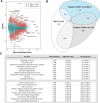Downregulation of exhausted cytotoxic T cells in gene expression networks of multisystem inflammatory syndrome in children
- PMID: 34381049
- PMCID: PMC8357784
- DOI: 10.1038/s41467-021-24981-1
Downregulation of exhausted cytotoxic T cells in gene expression networks of multisystem inflammatory syndrome in children
Abstract
Multisystem inflammatory syndrome in children (MIS-C) presents with fever, inflammation and pathology of multiple organs in individuals under 21 years of age in the weeks following severe acute respiratory syndrome coronavirus 2 (SARS-CoV-2) infection. Although an autoimmune pathogenesis has been proposed, the genes, pathways and cell types causal to this new disease remain unknown. Here we perform RNA sequencing of blood from patients with MIS-C and controls to find disease-associated genes clustered in a co-expression module annotated to CD56dimCD57+ natural killer (NK) cells and exhausted CD8+ T cells. A similar transcriptome signature is replicated in an independent cohort of Kawasaki disease (KD), the related condition after which MIS-C was initially named. Probing a probabilistic causal network previously constructed from over 1,000 blood transcriptomes both validates the structure of this module and reveals nine key regulators, including TBX21, a central coordinator of exhausted CD8+ T cell differentiation. Together, this unbiased, transcriptome-wide survey implicates downregulation of NK cells and cytotoxic T cell exhaustion in the pathogenesis of MIS-C.
© 2021. The Author(s).
Conflict of interest statement
S.G. reports consultancy and/or advisory roles for Merck, Neon Therapeutics and OncoMed and research funding from Bristol-Myers Squibb, Genentech, Immune Design, Agenus, Janssen R&D, Pfizer, Takeda, and Regeneron. No other author claims competing interests.
Figures





Update of
-
Cytotoxic lymphocytes are dysregulated in multisystem inflammatory syndrome in children.medRxiv [Preprint]. 2020 Sep 2:2020.08.29.20182899. doi: 10.1101/2020.08.29.20182899. medRxiv. 2020. Update in: Nat Commun. 2021 Aug 11;12(1):4854. doi: 10.1038/s41467-021-24981-1. PMID: 32909006 Free PMC article. Updated. Preprint.
References
-
- Center for Disease Control and Prevention. HAN Archive-00432|HealthAlert Network (HAN). https://emergency.cdc.gov/han/2020/han00432.asp (2020).
-
- Center for Disease Control and Prevention. Kawasaki Syndromehttps://www.cdc.gov/kawasaki/index.html (2020).
Publication types
MeSH terms
Substances
Supplementary concepts
Grants and funding
LinkOut - more resources
Full Text Sources
Medical
Molecular Biology Databases
Research Materials
Miscellaneous

